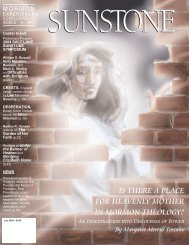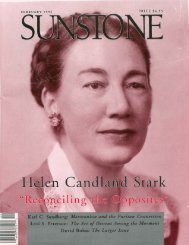Download Entire Issue PDF - Sunstone Magazine
Download Entire Issue PDF - Sunstone Magazine
Download Entire Issue PDF - Sunstone Magazine
Create successful ePaper yourself
Turn your PDF publications into a flip-book with our unique Google optimized e-Paper software.
S U N S T O N E<br />
To be learned is good if you pay your tithing<br />
THE MONITORING OF BYU<br />
FACULTY TITHING PAYMENTS<br />
1957–1963<br />
By Gary James Bergera<br />
SHORTLY AFTER HIS APPOINTMENT IN 1951 AS<br />
president of the LDS Church’s educational flagship,<br />
Brigham Young University, Ernest L. Wilkinson<br />
(1899–1978) began scrutinizing his faculty’s compliance to<br />
LDS teachings. 1 For a time, his attention focused especially<br />
on tithing contributions. All practicing Church members are<br />
expected to pay to their local congregations at least onetenth<br />
of their annual income, though how this is defined<br />
and how faithfully members adhere to this expectation are<br />
considered personal matters between members and their<br />
local religious leader(s). 2 Members’ church status is determined,<br />
in part, by their meeting their tithing obligations.<br />
Wilkinson himself paid his own tithing, and he expected<br />
nothing less from his faculty.<br />
Wilkinson also understood that if he hoped to secure<br />
Church funding for BYU, the school’s board of trustees, all<br />
members of the Church’s governing hierarchy, might respond<br />
less positively if faculty were found to be less than<br />
full tithepayers. In fact, following the precedent of past<br />
practices at the LDS school, Wilkinson decided to use an<br />
individual’s tithing history to help determine raises, promotions,<br />
and even continuing employment. However,<br />
some Church leaders and faculty members believed that<br />
Wilkinson’s actions intruded into a very private matter, effectively<br />
undermining a member’s relationship with his or<br />
her local Church leaders. Securing compliance proved to<br />
be challenging, as both Wilkinson and LDS authorities<br />
struggled to strike a balance between privacy and<br />
Wilkinson’s desire to know.<br />
GARY JAMES BERGERA is the managing director of the<br />
Smith-Pettit Foundation. From 1985 to 2000, he was Director<br />
of Publishing at Signature Books; from 1992 to 1998, he was<br />
Managing Editor of Dialogue: A Journal of Mormon<br />
Thought.<br />
“YOU ARE NOT EXPECTED TO RETAIN<br />
PERMANENTLY ON YOUR STAFF NON-TITHEPAYERS”<br />
WILKINSON WAS NOT the first BYU administrator to address<br />
the issue of faculty tithing. Early 1910s attempts to automatically<br />
deduct tithing from BYU salaries were scuttled in<br />
the face of a chorus of faculty complaints. Young physics instructor<br />
Harvey Fletcher (1884–1981) “exploded” at the<br />
news, telling administrators “in no uncertain terms” that<br />
“under these conditions the tithing was not a donation, it<br />
was a tax.” 3 While the automatic salary deduction was abandoned,<br />
LDS officials remained concerned and by mid-1915<br />
had compiled a list of sixty-seven faculty members and the<br />
tithing each had paid. 4 Of the sixty-seven, thirty-one (46<br />
percent) had not paid a full tithe. 5<br />
By 1929, the payment of a full tithe had become virtually<br />
de rigueur for all Church-employed school teachers. “Those<br />
who cannot conscientiously do these things,” wrote LDS<br />
Commissioner of Education (and later apostle) Joseph F.<br />
Merrill (1868–1952), “should not, we believe, be encouraged<br />
to remain in the employ of the Church school<br />
system.” 6 Two years later, at Merrill’s urging, BYU President<br />
Franklin S. Harris (1884–1960) convened a special faculty<br />
meeting to discuss loyalty to the Church, including the<br />
payment of tithing. Enclosed with Merrill’s request was a<br />
summary the Church’s Presiding Bishop’s office had provided<br />
of the tithing records of all faculty for the previous<br />
year. Of the 102 faculty identified, slightly more than half<br />
had paid a full tithing, 37 percent had paid a partial tithing,<br />
and 8 percent had paid no tithing. “You are not expected to<br />
retain permanently on your staff non-tithepayers,” Merrill<br />
subsequently reminded Harris. 7<br />
Despite repeated exhortations, 1934 figures reveal that,<br />
compared to 1931, the number of faculty paying a full<br />
tithing had actually decreased 19 percent, the number<br />
PAGE 42 OCTOBER 2011

















